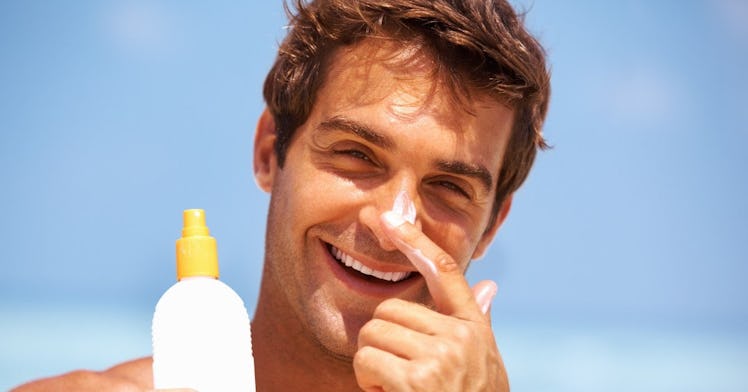The Best Sunscreens For Your Face — And How And When To Use Them
Daily sunscreen for your face is essential to help prevent skin cancer. Here's where to start.

Before heading outside for any amount of time, you need to apply sunscreen on your face. Every. Single. Time. According to the Skin Cancer Foundation, daily use of SPF 15 sunscreen can lower your risk of developing squamous cell carcinoma by roughly 40 percent, and reduce your melanoma risk by 50 percent. That’s a lot of benefit, from a habit that takes less than a minute of your time.
So where to start? We consulted Dr. Claire Wolinsky M.D., Dr. Rachel Westbay M.D., and Dr. Hysem Eldik M.D., who are all New York City-based board-certified dermatologists, for all the SPF facts, frequently asked questions, and what bottles to buy.
What SPF number should I buy?
SPF actually means ‘sun protection factor’. Dr. Wolinsky says to opt for an SPF of 30 because we get 97 percent protection against UVB rays when we use it correctly (meaning applying about one ounce every two hours), while an SPF of 15 provides 93 percent coverage. Beyond SPF 30, the benefits are incremental and not exactly worth it.
“The quantity of sunscreen used and the reapplication of sunscreen every two hours is much more important than whether it's a cream, gel, bar or spray formulation,” says Dr. Wolinsky. “Whatever feels best on your skin and whatever you will use the most is the right choice for you. That being said, it’s easier to misuse spray sunscreen because the quantity of sunscreen that is released from the nozzle is typically less than what you would get from a cream. Also, powder sunscreens, which I love, shouldn’t be used as the only sunscreen if possible but rather as an adjunct to regular sunscreen.”
It’s important to remember that high-number SPFs last the same amount of time as low-number SPFs. And a high SPF does not allow you to spend additional time outdoors without reapplication. Your sunscreens should always offer broad-spectrum (UVA and UVB) protection and ideally should be water-resistant for sweat and swimming.
How much SPF should I put on?
“Apply enough sunscreen to cover all skin that clothing will not cover. Most adults need about 1 ounce — or enough to fill a shot glass — to fully cover their body. Allow sunscreen to dry skin 15 minutes before going outdoors. When outdoors, reapply sunscreen approximately every two hours, or after swimming, sweating or any other water exposure,” says Dr. Westbay.
When applying sunscreen in the morning as the last step in your skincare routine, many like to follow the three finger rule. Meaning, the amount of sunscreen you use for your face and neck should be three fingers length which generally is about a tablespoon.
Physical or chemical sunscreen — what’s the difference?
These words are thrown around a LOT to describe different types of sunscreen formulas. But it can definitely be hard to remember which kind does what and the benefits.
In short, physical sunscreens (also called mineral) contain either zinc or titanium oxide. This creates a barrier between you and the sun as the product sits on top of your skin. Physical sunscreens also block both UVA & UVB rays and work immediately once applying.Choose physical SPFs when spending a lot of time in the sun, either walking around outside or soaking up the sun on a beach day.
However, chemical sunscreens absorb into the skin and convert UV rays to heat. They’re generally pretty thin and great for everyday use. Most have added skincare ingredients like hyaluronic acid or niacinamide too. Stick to chemical sunscreens for everyday use as the last step in your skincare routine. And yes, you still need to apply even when you’re inside all day. We doubt you live in a cave with no windows and zero sun exposure. Although inside exposure is minimal, it certainly adds up overtime!
In addition to SPF, how can we protect our skin from the sun?
We’ve all been there, forgetting to reapply and not noticing we’re burning or worse; falling asleep in the sun. Setting timers when you’re having a long day out in the sun is helpful or trying out these nifty UV stickers that turn colors when it's time to reapply can help.
“Limit sun exposure during peak hours from 10 to 2. You can wear some protective clothing that has UV protection. Wide brim hats, sunglasses, staying out of sun exposed areas while at the beach, etc. There are also supplementations known as heliocare that can also help decrease sensitivity to the sun,” says Dr. Eldik
Every product on Fatherly is independently selected by our editors, writers, and experts. If you click a link on our site and buy something, we may earn an affiliate commission.
This article was originally published on